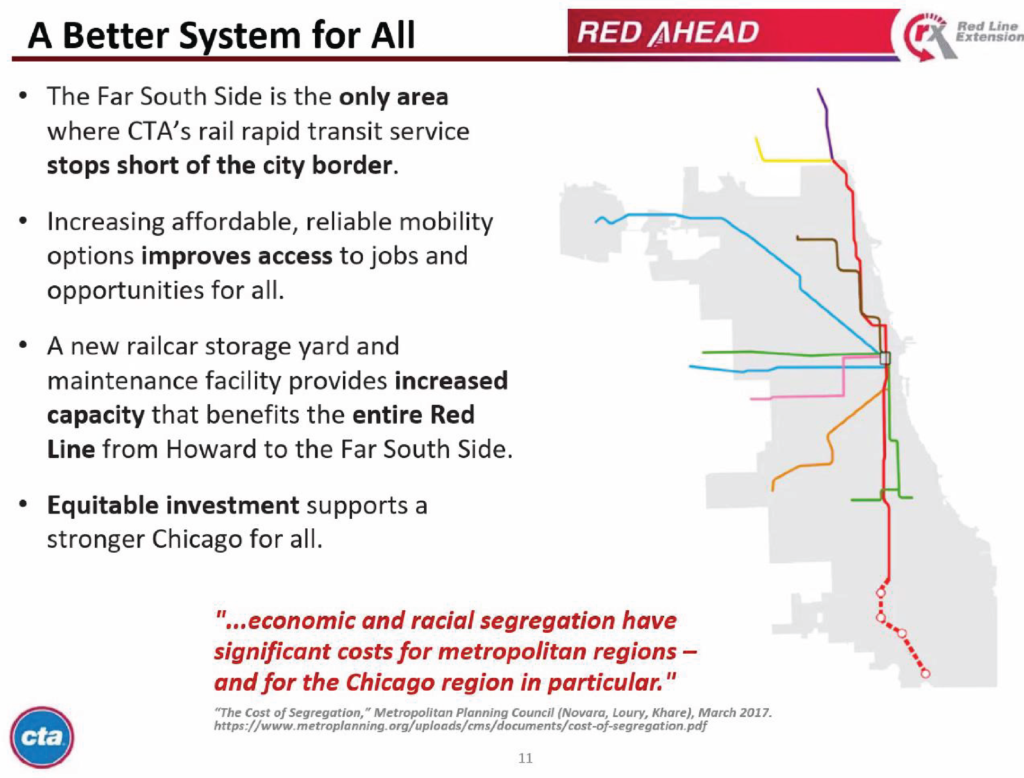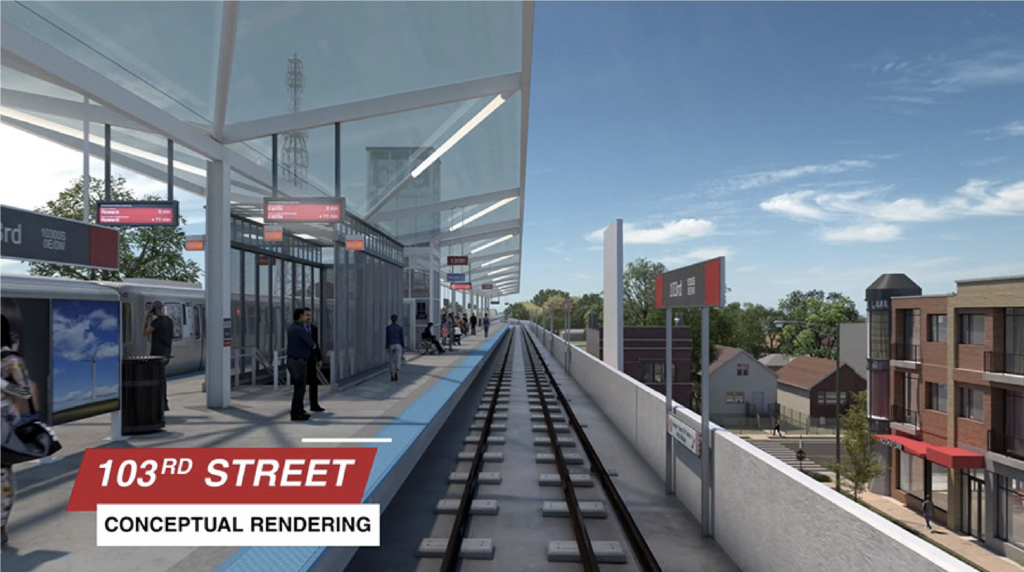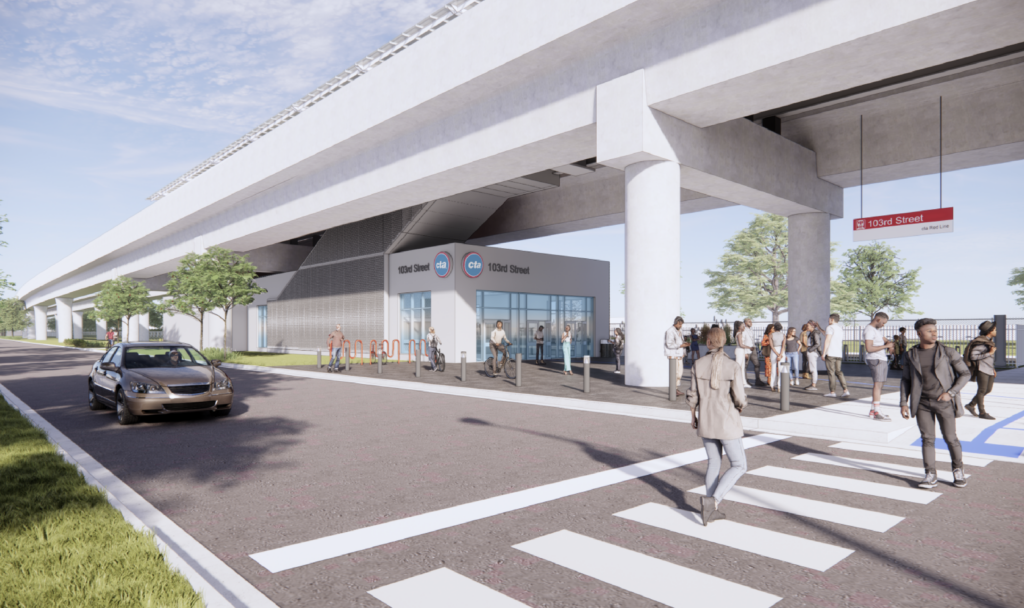An updated cost has been revealed for the CTA Red Line Extension (RLE) as the agency selects a contractor ahead of construction. Stretching all the way down to 130th Street once completed, the project has been in development for over a decade and recently received additional funding from the federal government.

Project context for the Red Line Extension via CTA
Originally set to cost $3.6 billion, earlier this week the CTA announced that figure had grown to $5.3 billion due to high interest rates as well as a 60-percent increase in construction labor and materials. However the transit agency expressed they intend to secure funding for the budget increase with CTA-issued bonds.

Conceptual rendering of 103rd Station via CTA
In order to help bring the project to reality, the Federal Transit Administration more than doubled their funding for the first year of construction earlier this month. This brought their contribution up to $764 million from the originally announced $350 million. With that, the CTA awarded a $2.9 billion contract to Walsh-VINCI Transit Community Partners.

Conceptual rendering of 103rd Station via CTA
The design-build Transit Community Partnership is made up of Walsh Construction, VINCI Construction, Systra, and EXP, all of which have extensive transit experience including with the CTA. While official construction is set to commence next year, preliminary site work, demolition, and utility relocation will kick off this fall.

Project context for the Red Line Extension via CTA
Once completed in 2030, the 5.6-mile extension will utilize a mix of elevated and grade level tracks stretching from the current terminus at 95th Street down to 130th Street. Bringing new accessible stations at 103rd Street, 111th Street, Michigan Avenue, and 130th Street, as well as a new train yard and shop on 120th Street near the Metra KYD facility.
The RLE will help connect over 100,000 Chicagoans with no train access to the city, cutting current commute times to The Loop up to 30 minutes. A press release on the contractor award can be found here, and one for the funding can be found here.
Subscribe to YIMBY’s daily e-mail
Follow YIMBYgram for real-time photo updates
Like YIMBY on Facebook
Follow YIMBY’s Twitter for the latest in YIMBYnews


5.6 billion for four stations is laughable
That is truly appalling. 5 billion, wow. I am just at a loss for words.
Total waste of money. This pandering wastefulness is why we can’t have nice things.
That is The United States’ Public Transit infrastructure cost in a nutshell right there for ya.
I am by no means defending this — but that’s why Highways continue to be built and expanded upon. Maybe horrible investments in the long-term for the tax payer and maintenance as we may all know, but they’re cheaper to invest in at face value over Public Transit. Government subsidies included, not so much.
But I’m not one bit surprised about this dollar amount unfortunately. Really spells the picture that it’ll take moving heaven and earth to ever get an actual other train line built in this city.
expect the cost to double again by the time it’s finished (if it ever gets finished)
Fantastic Project. a good lesson on how much project costs can increase when you delay execution. Probably could have built this for half the cost when it was designed 10 years ago. Glad to see it finally moving.
The rebuild of the north branch of Lake Shore Drive is reported to cost $3.5B and no one blinks an eye. Much of the problem for why these projects cost so much is because we don’t do it enough for any contractor to have enough experience doing them, so they inflate the costs. If we had been building transit like we’ve been building highways over the past 70 years, our costs wouldn’t be much different than Europe and Asia. Doing a one-off here and there with years in between leads to inflated costs. And then we get complainers that we shouldn’t be doing it at all because of costs, which leads to more of the same. We need to break ourselves out of this highway rut. This project will enhance these neighborhoods rather than destroying them like highways have done.
Well said
100% agree on this!! One of my friends works for Walsh Construction and is currently working on the Northside Red Line rebuild and said that for every transit project is usually anywhere from 20-25 road projects that he’s worked on. The more we prioritize transit the more costs will come down as contractors will be more experienced with building them like they are with highways. Its not that they are’t knowledgeable, he said its mostly due to the complexities with it as almost every transit system is built completely different than the next whereas highways are more of the same thing we’ve been doing for 60+ years.
While I don’t disagree with the concern over disproportionate funding that road projects receive, it’s important to note that the LSD project is about 25% longer and involves multiple times more land (including the parkland, etc.).
I’m certainly not suggesting we should build roads due to the cost, but this project does seem to be very costly, particularly considering that the Metra Electric runs pretty close to most of the stations.
Government procrastination doubles taxpayer liability!! That being said the folks that live the areas that will be served will appropriately benefit.
Usually i’m negative but I think that cost includes land acquisition, track structure infrastructure, substations, line termination depot and a lot of other complicated specialized items to keep the system safe. It’s more than a couple stations. It’s reasonable to expect prices to go up over time so I don’t think these types of public infrastructure are always going to match original planned costs. Construction costs and inflation have been unpredictable for all of us. Let’s not slam public agencies with generalized negativism.
A couple billion less than the Bears stadium dream to help bring the Southside along. Happy to live in the TIF and help pay for it.